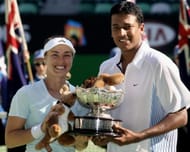In tennis, unlike in badminton, the game of doubles has always played second fiddle to the game of singles. Thus, one need not be an expert to understand the status of mixed doubles which does not even contribute to WTA/ATP rankings. The winners of the 2012 US Open took home $150,000 – a figure which is much less than what the men’s or women’s doubles losing finalists earned – $210,000.
Incidentally, a 4th round appearance in singles gave a player $120,000. Despite these wide discrepancies in prize money distributions, there was a time when top singles players did not shy away from playing in this category. Martina Navratilova has won 59 slams, out of which 10 came in mixed doubles.
Even five years back or so, a Venus Williams or a Martina Hingis would not be an anomaly in the mixed doubles draws. However, the rising physicality and competitiveness of the sport has made it difficult for top athletes to balance singles and doubles, let alone play mixed doubles.
Last year was, of course, an exception, with mixed doubles returning to the Olympics for the first time since 1924. Thus, we had the then World No 1 (in women’s singles) Victoria Azarenka teaming up with compatriot Max Miryni at Wimbledon, and ultimately emerging as the gold medalists at London Olympics.
Serena Williams and Bob Bryan were not as lucky. They faltered in Round 1 of the French Open and gave up the idea of playing together at London. This was Serena’s first Grand Slam mixed doubles match since partnering Max Mirnyi in 1998. A few others, like silver medalists Andy Murray and Laura Robson, chose the Hopman Cup for match practice.
However, since the end of the Olympics, there has been little participation from top singles players, and even the regular mixed doubles teams of Mahesh Bhupathi/Sania Mirza, Lisa Raymond/Mike Bryan and Ekaterina Makarova/Bruno Soares have broken up. In the last 3 years or so, not a single team has managed to win more than one mixed doubles title, even as many wild card entrants have triumphed in between.
In fact, the Bryan brothers did not even enter the event in this year’s French Open and Wimbledon. Thanks to such break-ups and random pairings, a 17th ranked Sania Mirza was the top seed at Roland Garros 2013 (along with Robert Lindstedt), only to crash out in the first round. Mahesh Bhupathi, the sole player in the Open Era to have won all the four mixed doubles slams twice, did not even clear the first hurdle in his last two Grand Slam appearances.
The inconsistency of top mixed doubles players is as much a result of frequent changes of partners as that of the lack of effort on the part of ITF to popularise this category of tennis. The common belief remains that women are easy targets and serve as mere eye candy on a mixed doubles court while the result is decided by the prowess of the men. A spectator, however, is bound to contend otherwise.
Hard-hitting women like Kristina Mladenovic, Bethanie Mattek-Sands, Sania Mirza and Elena Vesnina are capable of embarrassing the men (twice as big as them) with thunderous returns and confident net plays. It is no longer rare to see a Jarmila Gajdosova or an Ekaterina Makarova slamming down aces past bewildered male opponents.
Mladenovic, the losing finalist at Roland Garros 2013, says in an interview, “I have a very good opinion about mixed doubles and so far, it has helped me a lot for my singles game”. However, with deeper runs in singles, the French lady, like Makarova and Mattek-Sands, may also stop playing mixed doubles.
One hopes that at least the “doubles specialists” will form long-term partnerships and spare the fans the random nature of the title winners that has made the sport a lottery of sorts in recent years. But then, as long as mixed doubles is restricted to the four Grand Slams and a few exhibition tournaments, it will continue to be a neglected field of tennis.

